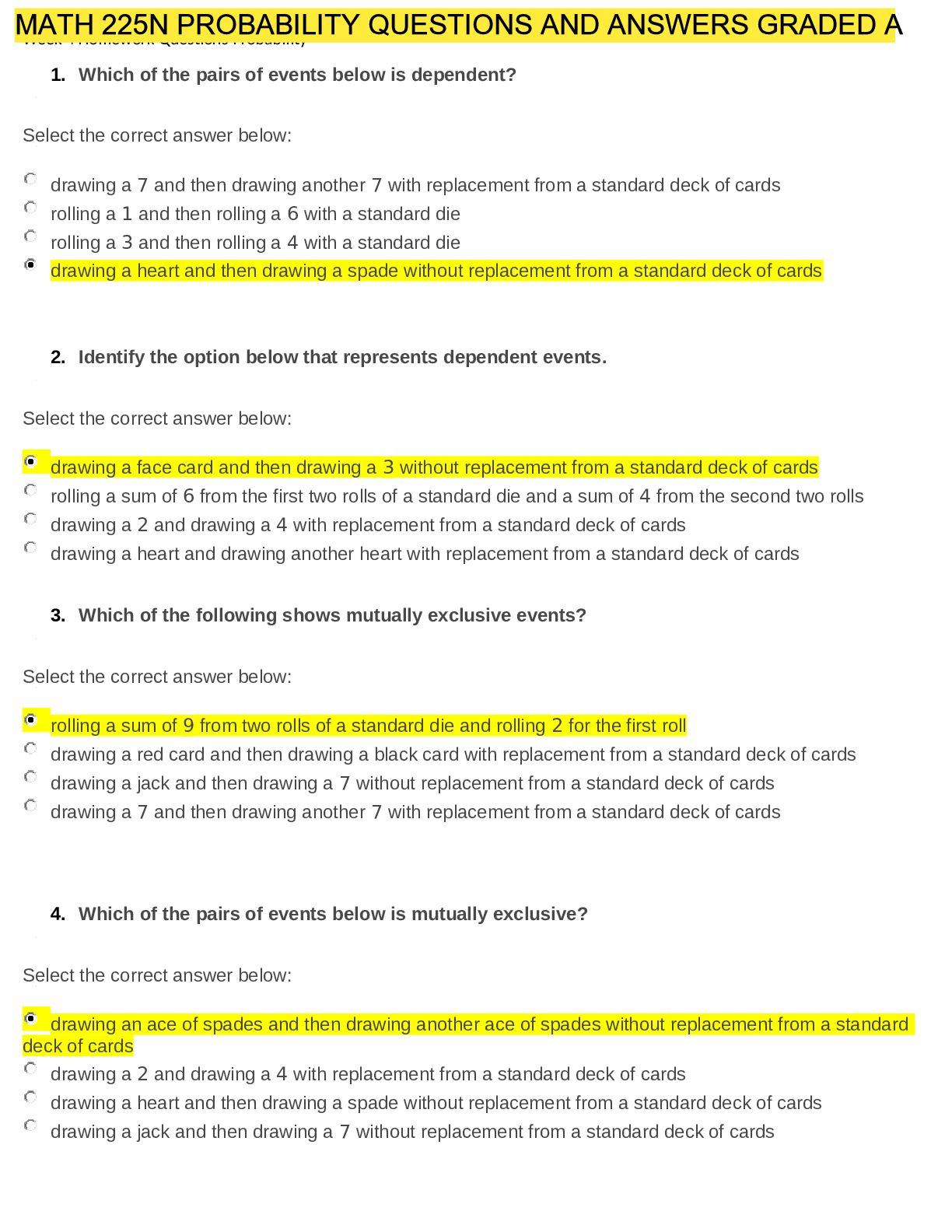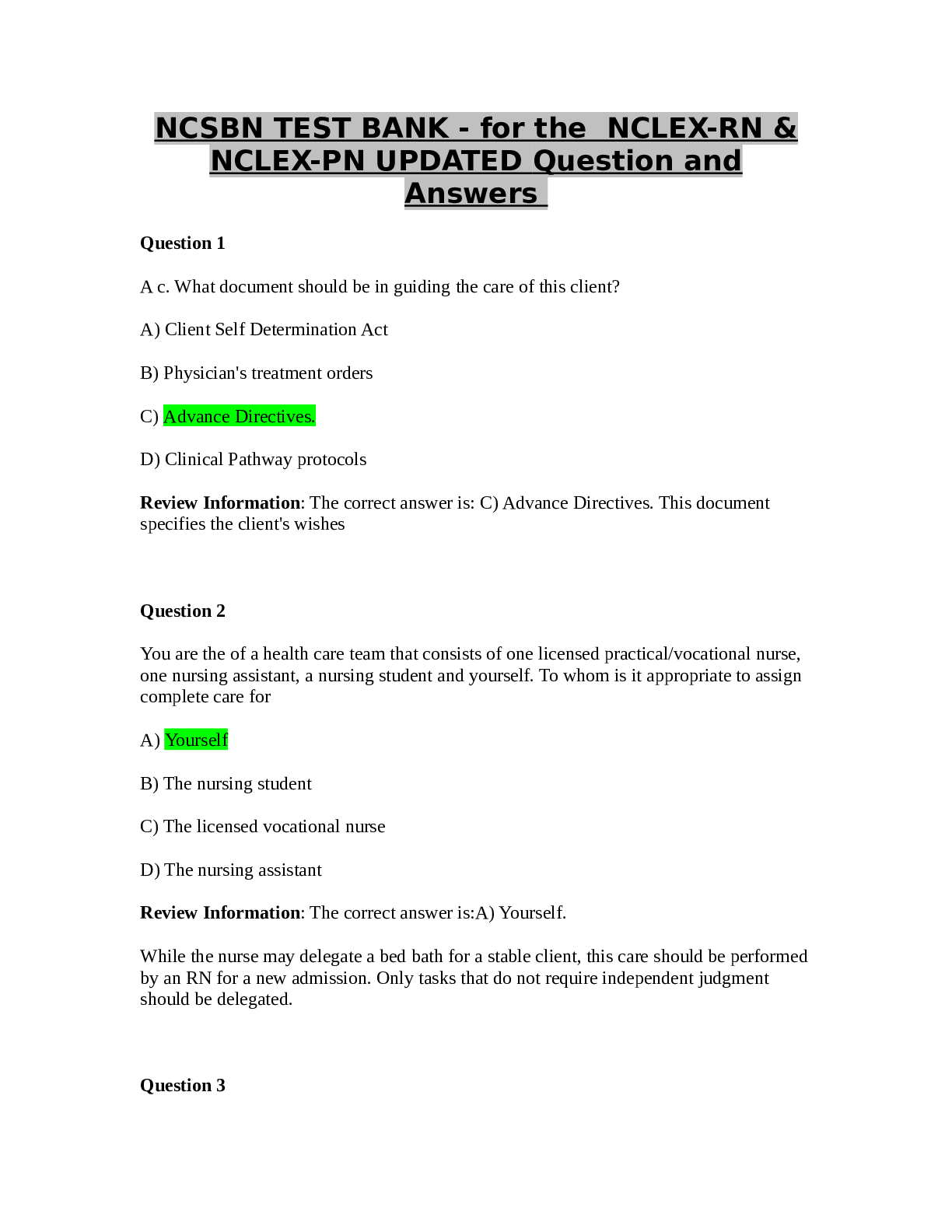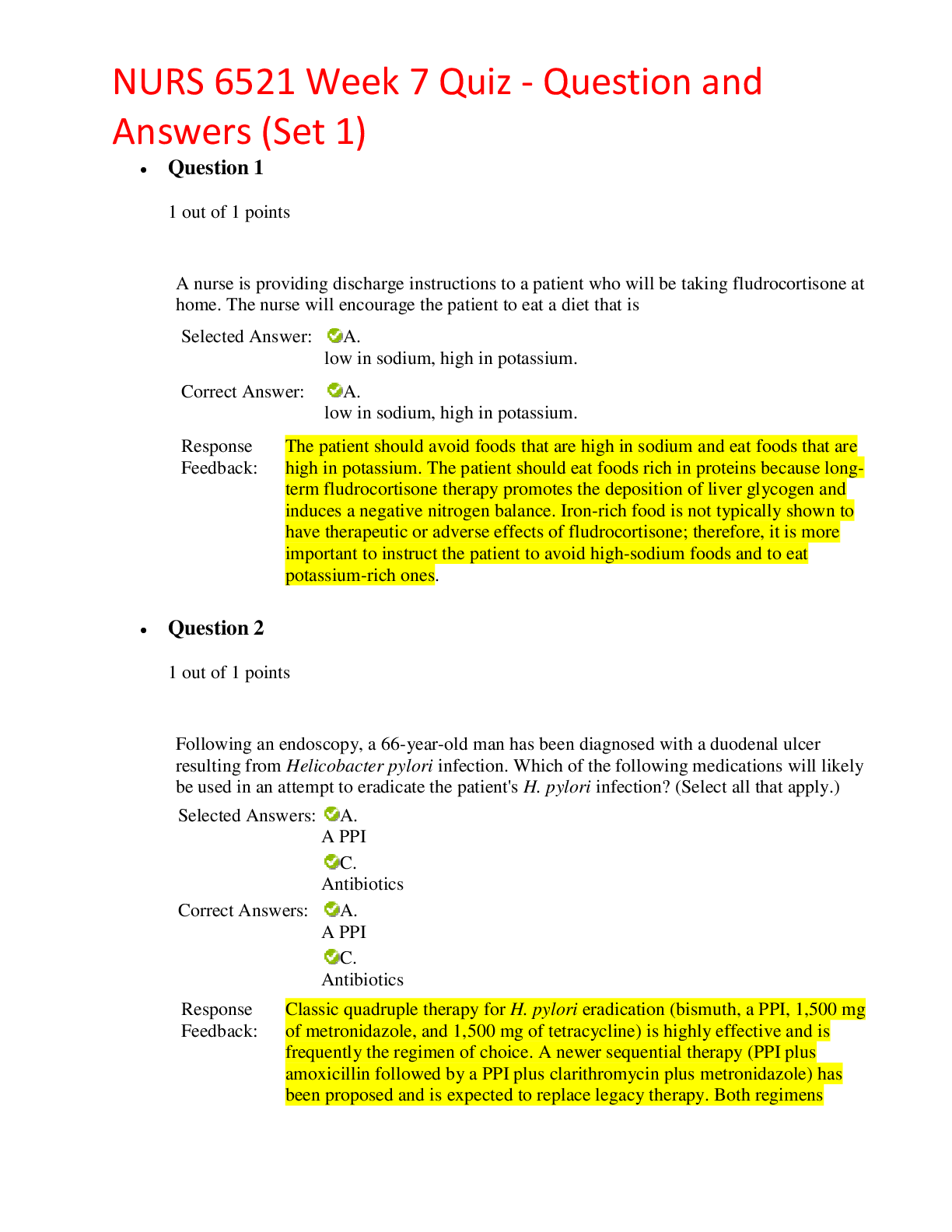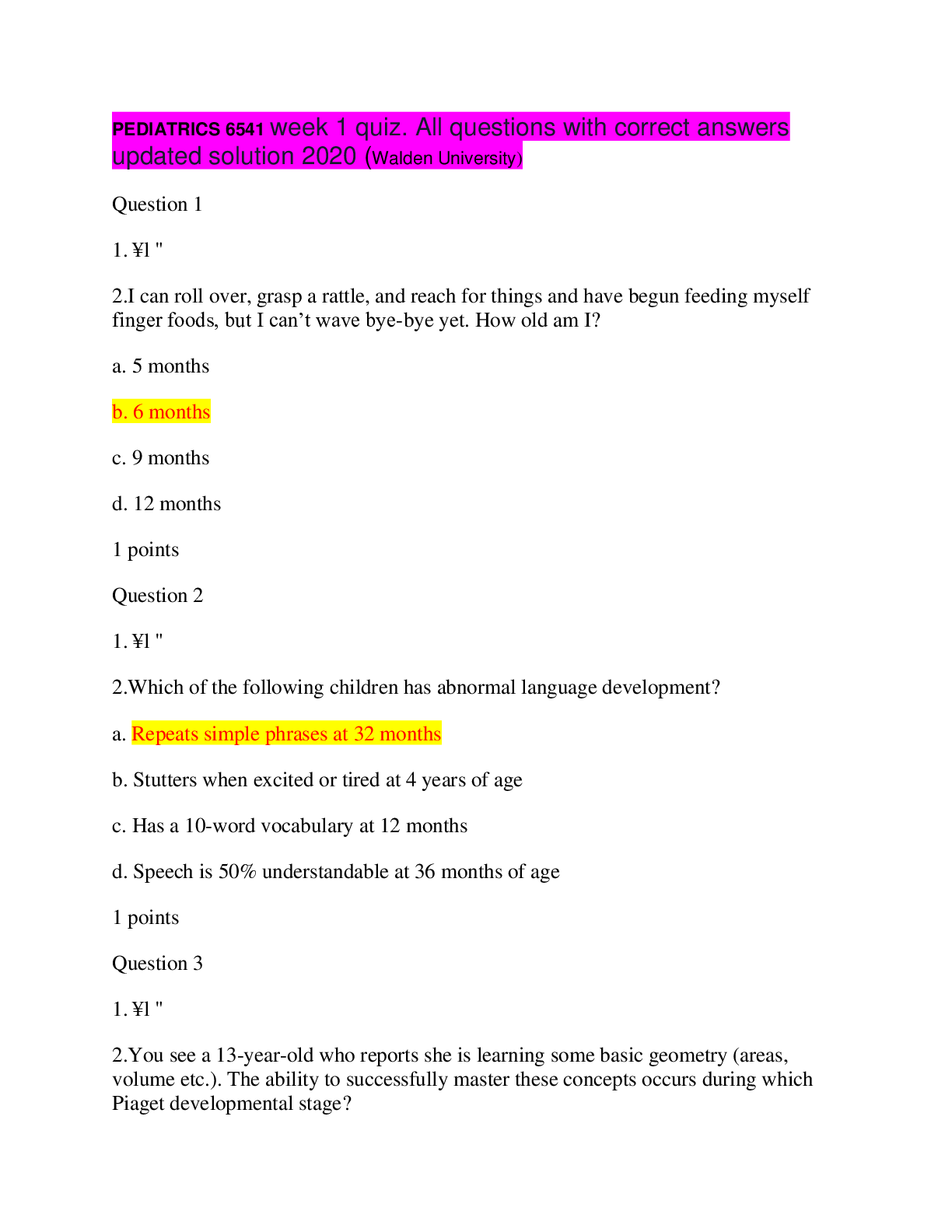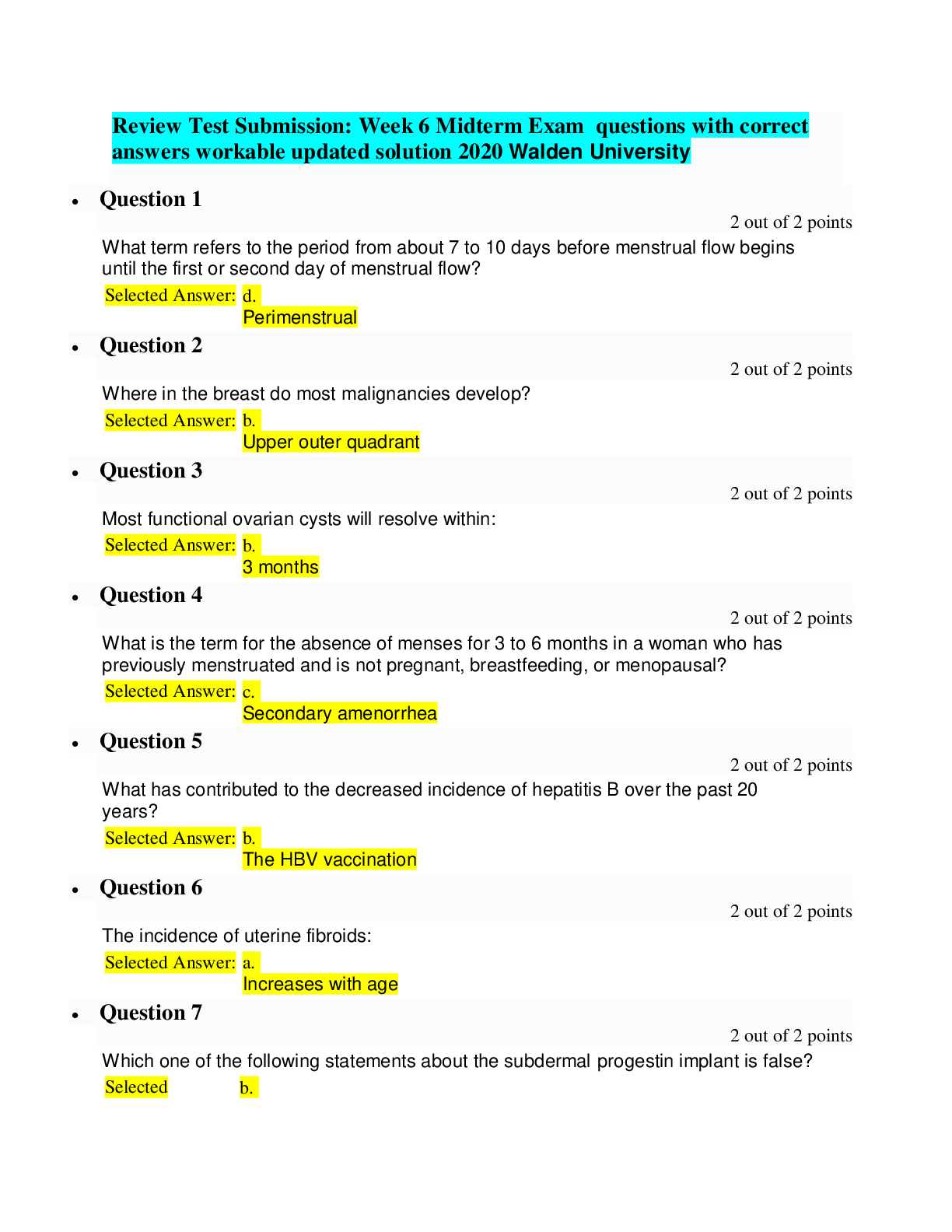*NURSING > QUESTIONS & ANSWERS > Miami Dade College, Miami NUR 1234 Lesson 05- Electrolyte Imbalances, part 2. Questions 40. With cor (All)
Miami Dade College, Miami NUR 1234 Lesson 05- Electrolyte Imbalances, part 2. Questions 40. With correct Answers Indicated. LATEST 2021/2022
Document Content and Description Below
Lesson 05 - Electrolyte Imbalances, Part 2 Due Mar 31 at 11:59pm Points 40 Questions 40 Available Mar 18 at 12am - Mar 31 at 11:59pm 14 days Time Limit None Question 1 Not yet graded / 1 pts Your Answ... er: Exercise 1 - Writing Activity This exercise will take approximately 20 minutes to complete. Exercise 1 - Question 1 Complete the following information for calcium. Normal level Functions Major location Mechanism(s) of electrolyte hemeostasis Normal level for calcium is 8.6-10.4 ECF—in both bound and unbound form; majority is bound to Question 2 Not yet graded / 1 pts Exercise 1 - Question 2 Complete the following information for phosphorous. Normal level Functions Major location Question 3 Not yet graded / 1 pts Your Answer: Exercise 1 - Question 3 Complete the following information for sodium. Normal level Functions Major location Mechanism(s) of electrolyte hemeostasis Normal level: 135-145 Functions: Helps maintain the balance of water in and around your Question 4 Not yet graded / 1 pts Your Answer: Exercise 1 - Question 4 Complete the following information for chloride. Normal level Functions Major location Mechanism(s) of electrolyte hemeostasis Normal Level: 98-106 Functions: It helps keep the amount of fluid inside and outside of your cells in balance. It also helps maintain proper blood volume, blood pressure, and pH of your body fluids. Most of the chloride in your body comes from the salt you eat Major Location: Can be found in the blood Mechanisms of electrolyte homeostasis: The predominant extracellular anion and it is a major contributor to the osmotic pressure gradient between the intracellular fluid and extracellular fluid. Chloride maintains proper hydration and functions to balance the cations in the ECF to keep the electrical neutrality of this fluid Question 5 Not yet graded / 1 pts Exercise 2 - Virtual Hospital Activity This exercise will take approximately 45 minutes to complete. Sign in to work at Pacific View Regional Hospital for Period of Care 1. (Note: If you are already in the virtual hospital from a previous exercise, click on Leave the Floor and then on Restart the Program to get to the sign-in window.) From the Patient List, select Pablo Rodriguez (Room 405). Click on Go to Nurses' Station. Click on Chart and then on 405. Click on Laboratory Reports. Question 6 Not yet graded / 1 pts Click on History and Physical and review this record. Exercise 2 - Question 2 What would be the most likely cause for the hyponatremia noted in this patient on admission? Question 7 Not yet graded / 1 pts Your Answer: Click on Physician's Orders. Exercise 2 - Question 3 What did the physician order to treat this electrolyte imbalance? Intravenous fluids of D5 0.45% NS at 150 ml/hr continuous infusion intake and output every 8 hours Neutra Phos Lactated Ringer's 1 L bolus followed by IV of D 0.45% NS at 150 mL/hr 5 Question 8 Not yet graded / 1 pts 5 Question 9 Not yet graded / 1 pts Your Answer: Exercise 2 - Question 5 Hyponatremia can be associated with both hypovolemia (actual sodium loss) and hypervolemia (dilutional). Initially, in the Emergency Department, what do you think Pablo Rodriguez’s volume status was? Explain. Pablo had Hypervolemia. During his assessment, he has crackles in the lungs, edema, bounding pulse, increase BP Question 10 Not yet graded / 1 pts Your Answer: Click on Return to Nurses’ Station. Click on EPR. Click on Login. Select 405 from the Patient drop-down menu and Intake and Output from the Category drop-down menu. Exercise 2 - Question 6 Record the intake and output shift totals for Tuesday 2300 and Wednesday 0700 for Pablo Rodriguez. Tuesday 2300: 580 Wednesday 0700: 3,066 Question 11 Not yet graded / 1 pts Your Answer: Exercise 2 - Question 7 Based on the above intake and output totals obtained after Pablo Rodriguez received IV replacement therapy, what factor(s) do you think may be contributing to the persistent hyponatremia? Explain your answer. Too much fluid buildup. Question 12 Not yet graded / 1 pts Your Answer: Exercise 2 - Question 8 What other laboratory tests might be useful to more accurately determine the patient’s hydration status? (Hint: See Chapter 11 in your textbook.) blood urea, potassium, calcium. magnesium and phosphate, blood glucose, plasma and urine osmolality Blood urea nitrogen (BUN), hemoglobin (Hgb), hematocrit (Hct), serum osmolality, protein, glucose, and other electrolytes Question 13 Not yet graded / 1 pts Your Answer: Click on Return to Nurses' Station. Click on 405 at the bottom of your screen. Click on Patient Care and then on Physical Assessment. Complete a physical assessment of Pablo Rodriguez by clicking on the body system categories (yellow buttons) and subcategories (green buttons). Exercise 2 - Question 9 Specifically looking for clinical manifestations of hyponatremia, document your findings below. Cardiovascular Respiratory Neuromuscular Gastrointestinal Cardiovascular: Tachycardia with anxiety and restlessness Respiratory: Labored and shallow respiratory effort. Tachypnea. Neuromuscular:Capillary refill sluggish at >4 seconds. Gastrointestinal: Last bowel movement on Tuesday of small hard stool reported as passed with difficulty. Question 14 Not yet graded / 1 pts Your Answer: Click on Chart and then 405. Click on Nursing Admission. Exercise 2 - Question 10 What other factors could be causing or contributing to the manifestations documented in question 9? Metastatic lung cancer Question 15 Not yet graded / 1 pts Your Answer: Exercise 2 - Question 11 Based on your answers to questions 9 and 10, what conclusion can you make regarding these clinical manifestations and Pablo Rodriguez’s sodium levels? the medication that the Doctor has him on is working. the sodium levels are slowly but surely going back to its normal value. Question 16 Not yet graded / 1 pts Your Answer: Exercise 2 - Question 12 What other clinical manifestations of hyponatremia might you expect to find in other patients with this electrolyte imbalance? (Hint: See Chapter 11 in your textbook.) fatigue, confusion, thirst, dizziness Question 17 Not yet graded / 1 pts Your Answer: Exercise 2 - Question 13 If Pablo Rodriguez’s sodium level were 120 (severe hyponatremia), how would the treatment vary? Severe restriction of water intake, no infusions , diuretic use The patient would receive small-volume infusions of hypertonic (2%-3%) saline via an IV controller with frequent monitoring. Question 18 Not yet graded / 1 pts Your Answer: Exercise 3 - Virtual Hospital Activity This exercise will take approximately 60 minutes to complete. Sign in to work at Pacific View Regional Hospital for Period of Care 3. (Note: If you are already in the virtual hospital from a previous exercise, click on Leave the Floor and then on Restart the Program to get to the sign-in window.) From the Patient List, select Pablo Rodriguez (Room 405). Click on Go to Nurses' Station. Click on Chart and then on 405. Click on Laboratory Reports. Exercise 3 - Question 1 What was Pablo Rodriguez’s calcium level on admission to the Emergency Department on Tuesday evening? 10.5 10.5 mg/dL Question 19 Not yet graded / 1 pts Exercise 3 - Question 2 How would you best describe this calcium level? Question 20 Not yet graded / 1 pts Your Answer: Exercise 3 - Question 3 What was his phosphorus level during the same time frame? 2.2 2.2 mg/dL Question 21 Not yet graded / 1 pts Exercise 3 - Question 4 How does this relate to his calcium level? Explain the pathophysiologic rationale supporting your answer. Question 22 Not yet graded / 1 pts Your Answer: Click on History and Physical. Exercise 3 - Question 5 What would be the most likely cause for Pablo Rodriguez’s calcium level? cancer, malnutrition and hypophosphatemia Malignancy; most likely direct invasion caused by metastatic non-small cell lung carcinoma Question 23 1 / 1 pts Exercise 3 - Question 6 Match each type of serum calcium imbalance with its potential cause listed below. (Note: Each imbalance may be used more than once.) (A) Hypercalcemia (B) Hypocalcemia Vitamin D deficiency B Hyperthyroidism A Hyperparathyroidism A Excessive intake of phosphorous containing foods B Kidney disease B Correct! Correct! Correct! Correct! Correct! Correct! Correct! Correct! Correct! Correct! Question 24 Not yet graded / 1 pts Click on Physician's Orders. Question 25 Not yet graded / 1 pts Your Answer: Click on Return to Nurses’ Station. Click on Drug Guide on the counter. Exercise 3 - Question 8 Describe the mechanism of action of the medication you identified in question 7. An electrolyte that participates in bone deposition, calcium metabolism, utilization of B complex vitamins, buffer in acid-base equilibrium. Laxative: Exerts osmotic effect in small intestine. Therapeutic Effect: Produces distention; promotes peristalsis, evacuation of bowel. Question 26 Not yet graded / 1 pts Your Answer: Exercise 3 - Question 9 What nursing assessments are appropriate related to the administration of this medication? Assess for the presence of gastrointestinal (GI) pain. Note its pattern, duration, quality, intensity, location, and areas of radiation, as well as factors that relieve or worsen the pain. Assess the amount, color, and consistency of the stool of the patient taking phosphates as a laxative. Assess the daily pattern of bowel activity and evaluate the bowel sounds for peristalsis of the patient taking phosphates as a laxative. Assess the patient for history of recent abdominal surgery, nausea, vomiting, and weight loss. Assess the results of baseline phosphate levels and urine pH. Question 27 Not yet graded / 1 pts Your Answer: Click on Return to Nurses’ Station. Click on Chart and then on 405. Click on Laboratory Reports. Exercise 3 - Question 10 What were Pablo Rodriguez’s calcium and phosphorus levels this morning (Wednesday at 0730)? calcium: 9.5 Phosphorus: 2.3 Question 28 Not yet graded / 1 pts Your Answer: Exercise 3 - Question 11 Was the prescribed medication effective? Is the patient out of danger? it was effective but he is not out of danger yet Yes, the serum calcium is lower and Pablo Rodriguez is not in any immediate danger. However, the patient is at risk for hypercalcemia secondary to ongoing malignancy issues and must be monitored closely. Question 29 Not yet graded / 1 pts Click on Return to Nurses’ Station. Click on Kardex and then on 405. Exercise 3 - Question 12 What IV fluids is Pablo Rodriguez receiving? Question 30 Not yet graded / 1 pts Your Answer: Exercise 3 - Question 13 What is the purpose of IV hydration in relation to serum calcium levels? the decrease in intravascular volume then potentiates increased sodium re-absorption proximally in the kidney. Isotonic saline restored the volume depletion that invariably occurs in the setting of hypercalcemia provoked urinary salt wasting IV hydration increases urine output and thus urine excretion of calcium. Question 31 Not yet graded / 1 pts Exercise 3 - Question 14 Question 32 Not yet graded / 1 pts Your Answer: Click on Return to Nurses’ Station. Click on MAR and then on 405. Exercise 3 - Question 15 What medication is scheduled to be administered at 1500? Dexamethasone 4 mg IV Neutra-Phos 1 capsule Question 33 Not yet graded / 1 pts Your Answer: Exercise 3 - Question 16 What electrolyte imbalance will this medication correct? Explain your answer. sodium. It is a corticosteroid that increased systolic blood pressure and decreased body weight (edema/fluids) It will directly increase the phosphorus levels and indirectly decrease calcium levels related to the reciprocal relationship between calcium and phosphorus. As you increase phosphorus levels, calcium levels will decrease, and vice versa. Question 34 Not yet graded / 1 pts Your Answer: Exercise 3 - Question 17 What nursing assessments must be completed before this drug is administered? Determine if the patient is hypersensitive to any corticosteroids. Obtain the patient's baselines for blood glucose levels, blood pressure (B/P), serum electrolyte levels, height, and weight. Question 35 Not yet graded / 1 pts Your Answer: Exercise 3 - Question 18 Do you have any concerns about administering this drug at this specific time? (Hint: Check the patient’s gastrointestinal [GI] history on admission.) no Question 36 Not yet graded / 1 pts Your Answer: Click on Return to Nurses’ Station. Go to Pablo Rodriguez's room by clicking on 405. Click on Patient Care and then on Physical Assessment. Complete a physical assessment on Pablo Rodriguez by clicking on the body system categories (yellow buttons) and subcategories (green buttons). Click on Take Vital Signs. Exercise 3 - Question 19 Document the findings of your assessment, focusing on the areas listed below. Cardiovascular Respiratory Neuromuscular Gastrointestinal Cardiovascular:Apical rate and rhythm regular and even. S1 and S2 auscultated.No murmurs, clicks, or rubs. No jugular vein distention. Respiratory:Shallow and even respiratory effort. Question 37 Not yet graded / 1 pts Your Answer: Exercise 3 - Question 20 Is Pablo Rodriguez demonstrating any clinical manifestations of hypercalcemia? If yes, describe the pathophysiologic basis for the symptoms. If not, explain why not. increased urination, generalized muscle weakness due to fatigue, Dry mouth and mucous membranes No clinical manifestations are noted because the patient’s calcium levels are within normal limits. Question 38 0.43 / 1 pts Exercise 3 - Question 21 If Pablo Rodriguez’s calcium level were 12.5, what other clinical manifestations might the nurse expect to find? Select all that apply. Cardiac dysrhythmias Tachycardia Bradycardia Question 39 Not yet graded / 1 pts Your Answer: Exercise 3 - Question 22 Based on your vascular assessment of Pablo Rodriguez, what complication of hypercalcemia must the nurse vigilantly assess for? Explain. Question 40 Not yet graded / 1 pts Your Answer: Exercise 3 - Question 23 After successful treatment of Pablo Rodriguez, the nurse must be alert for overcorrection of the electrolyte imbalance. For what clinical manifestations should the nurse monitor this patient related to hypocalcemia and hyperphosphatemia? [Show More]
Last updated: 2 years ago
Preview 1 out of 38 pages
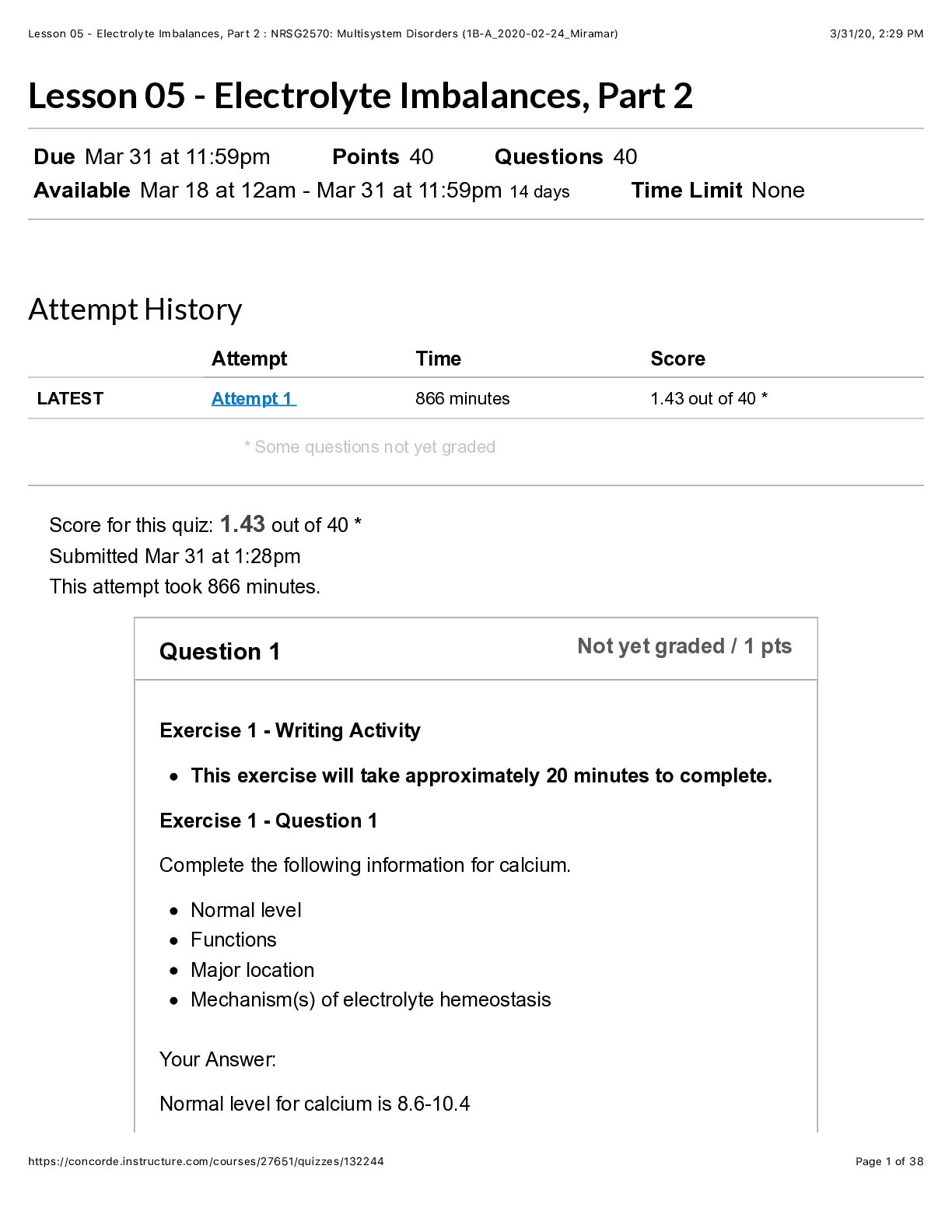
Buy this document to get the full access instantly
Instant Download Access after purchase
Buy NowInstant download
We Accept:

Reviews( 0 )
$13.50
Can't find what you want? Try our AI powered Search
Document information
Connected school, study & course
About the document
Uploaded On
Aug 03, 2021
Number of pages
38
Written in
Additional information
This document has been written for:
Uploaded
Aug 03, 2021
Downloads
0
Views
72






